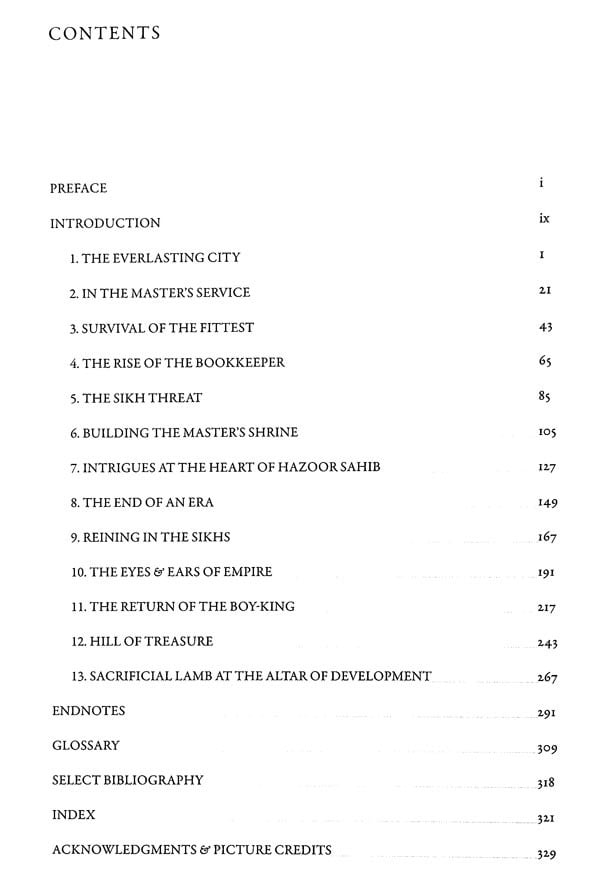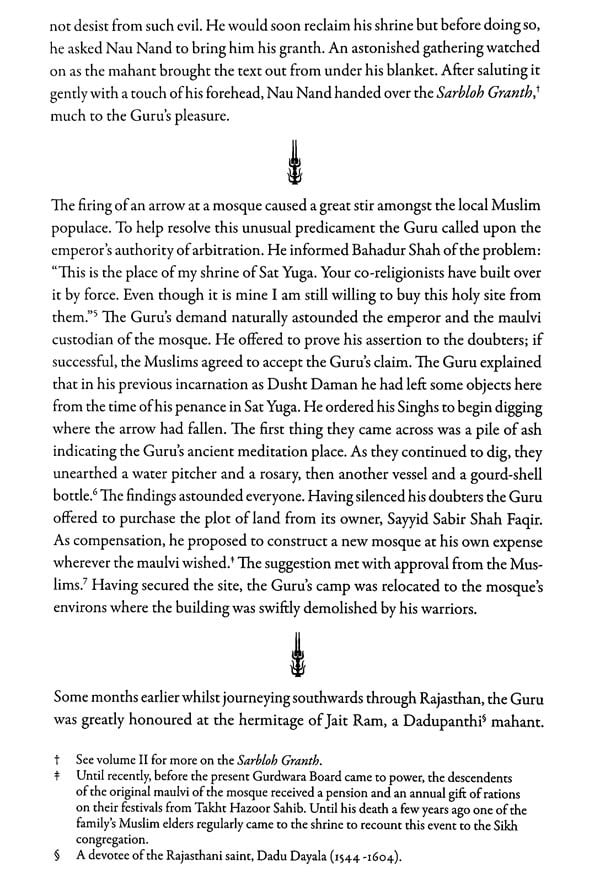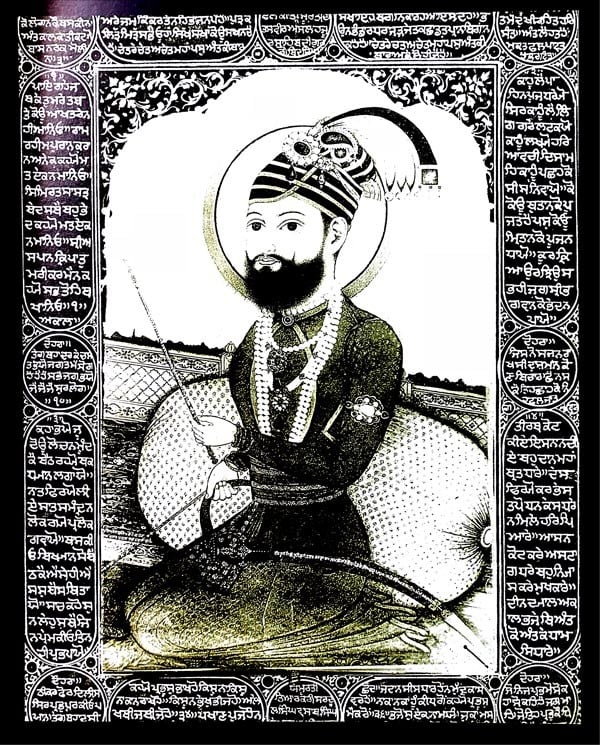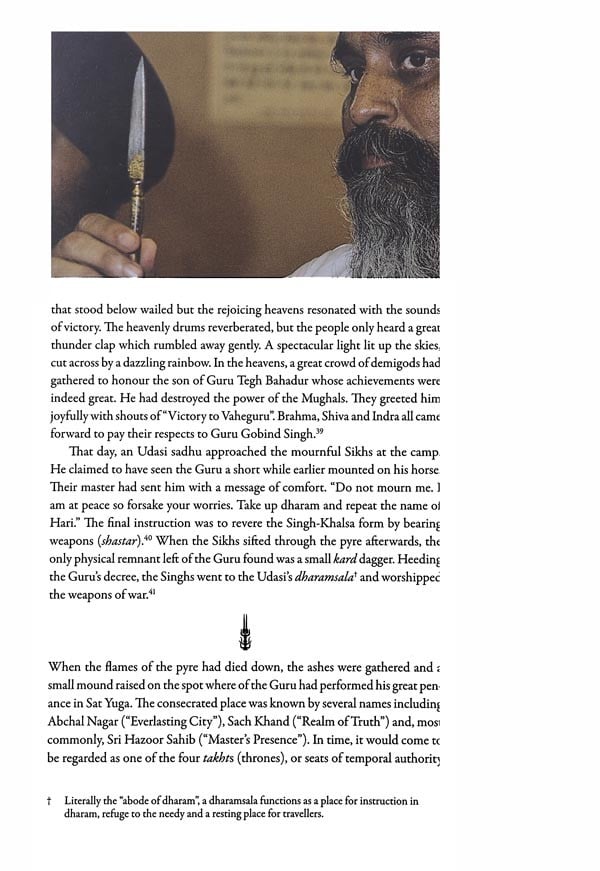
In the Master's Presence- The Sikhs of Hazoor Sahib (Part-1)
Book Specification
| Item Code: | AZG895 |
| Author: | Nidar Singh Nihang and Parmjit Singh |
| Publisher: | KASHI HOUSE |
| Language: | ENGLISH |
| Edition: | 2008 |
| ISBN: | 9780956016805 |
| Pages: | 348 (Throughout B/w and Color Illustrations) |
| Cover: | HARDCOVER |
| Other Details | 11.00x9.00 inch |
| Weight | 2.03 kg |
Book Description
This is first a two-volume work examining the history and traditions shrine Hazoor (which means 'Master's Presence"), revered the Sikh takht or throne temporal and spiritual author ity. The three centuries from very modest structure built over ashes Guru Gobind Singh the destruction" of unique heritage the of modernisation and beautifica tion.
authors have drawn upon wealth of materials oral tradition vivid startling account the empires, events and characters, including maharajas, warriors, emperors, nizams, politi cians and policemen, which sense mystery and reverence that surrounded memory the Sikh Guru.
PARMJIT SINGH is an independent researcher specialis ing in the photographic history of nineteenth-century Punjab. His previous publications include Warrior Saints: Three Centuries of the Sikh Military Tradition (L.B. Tauris, 1999) and Sicques, Tigers, or Thieves': Eye witness Accounts of the Sikhs (Palgrave Macmillan, 2004). He is currently working with Nidar Singh Nihang on a four-volume, official history of the Buddha Dal, the ancient warrior order of the Akali-Nihang Sikhs. Guru spent his last camped outside town Nanded, now Maharashtra State back then located within distant quarter sprawling Mughal Empire. Referred Sikhs Abchal Nagar ("Everlasting City"), small shrine dedicated the memory the tenth Guru was here soon after demise. Variously known Sach Khand ("Realm Truth") Hazoor Sahib ("Master's Presence"), the shrine's modest appearance belied significance the authority the Sikhs. The takht rapidly became the focal point of vibrant community of who their lives its service. The very first 'Hazoori Sikhs were riors and mendicants who adopted pattern of life has endured through time, change strife. Separated the Punjab hundreds of miles spared the post-annexation 'Dalhousian revolution that transformed Punjab into shining colonial jewel, Hazoori Sikhs steadfastly maintained ancient religious traditions and a fascinating oral history, which uncovers aspect Sikh history appears almost considered heresy. The Delhi Sultanate emerged the thirteenth century when Muslim rulers, mainly Turkish speakers, from Iran, Central Asia and Afghanistan, governed Northern India. Ruling from Delhi, and lured by reports of fabulous wealth, these Turks had infiltrated southwards the early fourteenth century and subdued the Deccan which until then had been ruled by Hindu kings. Islamic rule was prevail there the next six centuries, until 1950, when the last nizam Hyderabad relinquished power the Indian Union. remarkably varied population coloured the Deccani canvas. Not only were there Indian Muslims and Hindus, but also large and powerful communities of Turks, Persians, Arabs and Africans. Sufi mystics, scholars, writers, merchants and military men from over the Middle East came preach, write, trade conquer, lured by generous royal patronage. Until the Mughal conquest of 1687, the Deccan, with its long-standing commercial links with the Arab world across the Arabian Sea, became India's greatest centre of Arabic learning and literary composition. This mix races was culturally enriching for the region, but also source of perennial political instability with Muslim invariably fighting Muslim. Turks, Arabs and Persians formed clique of 'foreigners, comprising mainly Shia Muslims, who were bitterly opposed to the Sunni 'natives, the Indians and Afghans Literally "true devotee" This was the designation used for the Muslim devotees and allies the Sikh Gurus. Also written Nander. In Punjab, Muslim invaders came be regarded "Turks" a result their common linguistic heritage. **Contents and Sample Pages**















